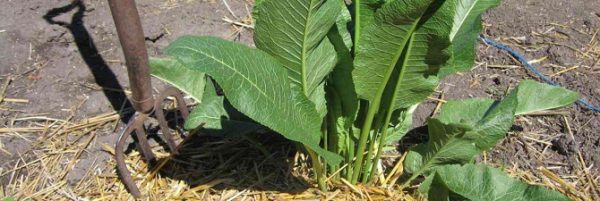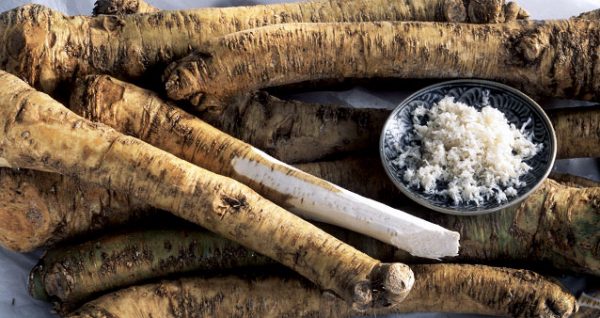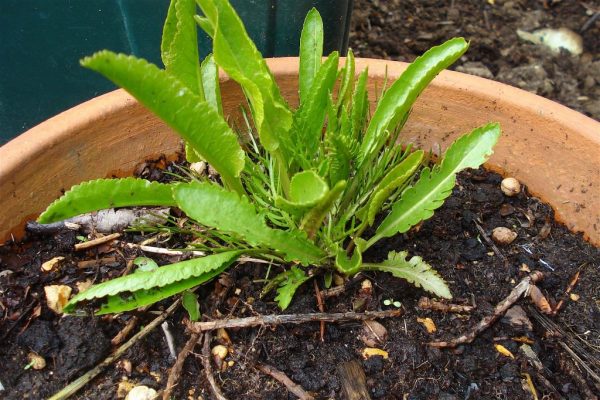How to plant horseradish in the garden: practical tips for growing
Content
Where is the best place to plant?
Planting horseradish does not require any special preparations, at least not more than any other plant. Try to choose a place where nothing has grown before or where early maturing crops grew. Beds of potatoes, beets, tomatoes, cucumbers are suitable.
The culture is unpretentious to the soil, but it is worth choosing a place on a site with loamy soil or drained peat bogs. Before planting, you need to properly prepare the soil. There are different methods of preparing the soil for the future shitty plantation. In one of them, you will need 6-8 kg of humus, 2 tbsp. spoons of nitrophoska, 3 tbsp. spoons of wood ash. All this must be mixed, dug up, diluted with water, and then the roots must be prepared for planting.
Another “recipe” is applied in the fall. 5-10 kg of manure, 70-100 g of superphosphate, 50 g of potassium chloride are imported to the selected site. Remember: the thicker the prepared soil layer, the better the horseradish will grow.
Video "On the method of growing horseradish in a barrel"
Informational video with an interesting proposal for planting and growing a plant in a barrel.
Planting in the garden
The cultivation of this crop requires preliminary seed preparation. Before planting seedlings, you need to take them out into the light for 35-40 days in order to awaken the buds. Cover the middle of the spines with tape and place in a warm place. Thus, many lateral roots are not formed and the plant will grow strong and powerful.
The roots sprouting from the seeds should be sorted out - it is better to put small roots into cooking, and cut large ones, 15-20 cm long. An incision is made from above - cutting off the top to make a ring, and from below - obliquely. So it will be more convenient to disassemble where is the top and where is the bottom of the horseradish. Next, the selected roots are wiped with a hard cloth or glove to remove small shoots, thereby controlling the reproduction of the culture.
In the spring, approximately in the second half of April, the cuttings are placed in the ground at an inclination of 30-40 °. Make sure that the distance between the roots is 20-30 cm, and between the beds - about 60 cm. Sprinkle the upper end of the cutting with earth and stamp it with your foot, creating a tight contact with the ground. Remember that this crop does not like shading, so do not allow densely growing fruit or berry plants to be adjacent to it. Best planted outdoors. By correctly planting seedlings on the site, you will receive a first-class product at home. In addition, transplanting this plant is a chore.
Growing and care
Caring for a plant is not difficult - it is extremely unpretentious. Water the plants regularly, do a thorough weeding, and loosen the soil between the beds. In the spring and summer, feed the plants with a mixture of urea, superphosphate, potassium chloride fertilizers - this will help propagate large, fleshy roots.
Another way to get thick roots is to remove the roots and cut the leaves.The ideal month is July, when the deciduous part grows to 18-20 cm. Carefully expose the upper part of the root, cut off all the shoots, and then carefully return the soil back and water the beds well.
Include pest control in plantation care. Babanukha willingly reproduces in the garden next to horseradish to huge populations. Insects eat away the leaves and rhizome of the plant. It is easy to destroy them, but you will have to do the rescue procedures several times per season. Prepare a warm mustard-pepper solution, in a ratio of 100 g of hot spices to 1 bucket of water.
Spray the leaves in the garden beds generously until the insects are completely eliminated. This will help you grow a good crop. When can you dig up horseradish? At the end of October, the rhizomes are already formed enough to send them to cooking.
How to limit horseradish
Care for the beds should be started long before planting the roots. The entire preparatory process takes place at home, without requiring special skills. There are several ways to isolate the horseradish growing area from the rest of the vegetation:
- old slate is suitable, which is cut into narrow strips, and then dug into the ground;
- before preparing the ground, the pit is lined with roofing material or linoleum;
- the least expensive option is plastic bottles, which are dug in with their neck down by 20-30 cm, tamp them well, sprinkle them with earth on top to make a neat fence;
- an elegant way is to plant horseradish in a barrel, small buckets or boils are suitable, where cuttings are planted, this method will greatly facilitate the care of the plants and prevent them from growing into neighboring beds.
Planted and carefully grown horseradish will thank you for your care and work with a rich harvest.
Video "Useful information about horseradish for gardeners"
In this video, an expert shares his knowledge of this wonderful root vegetable.




